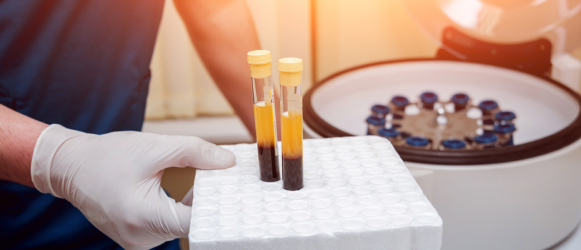Your journey to joint recovery starts here
PRP for joint pain at Panache Medical Aesthetics
Platelet-rich plasma (PRP) therapy is an effective treatment of mobility problems and joint discomfort. Panache Medical Aesthetics provides a safe and regenerative treatment for long-term relief from ailments like tendon injuries, and joint degeneration. With this innovative regenerative therapy, we assist you in regaining your active lifestyle. Dr Sobia skilfully performs the process of using your body’s own healing factors to restore damaged tissues and lower inflammation of joints with PRP therapy.

Composition of PRP
Platelet-rich plasma is a concentrated solution made from your own blood, containing elements that promote tissue regeneration and healing. It is rich in growth factors that significantly contribute to tissue repair and cell regeneration. Plasma, the liquid portion of blood, serves as a carrier for these platelets. During the preparation process, the majority of red blood cells are usually eliminated, leaving a solution with regenerative qualities. Platelet-rich plasma is an efficient, all-natural remedy for a number of ailments because of its healing factors.

PRP joint procedure
Our skin expert injects a required amount of your PRP straight into the joint or injured area. The injected PRP concentration accelerates the healing of damaged tendons, ligaments, muscles, bones, and joints. At our clinic, we are dedicated to helping people overcome pain and regain their mobility due to musculoskeletal injuries and boosting joint health. We carefully use sterile procedures and antiseptics to lower the risk of complications at every attempt. Since PRP uses your own blood, the risk of adverse effects are low. Sometimes, there may be a minute flare-up of stiffness, pain, and swelling, but this usually goes away with painkillers and rest. Within the first few weeks, there can be a noticeable improvement.
What joint conditions PRP can address?
We believe in providing ultimate solutions, making our PRP treatment for joint pain effective for multiple issues. Thus, it can efficiently address;
Osteoarthritis
Promotes cartilage healing in degenerative joint diseases, resulting in lowering pain and inflammation. It can also postpone the necessity for surgery.
Sports injuries
Addresses common joint issues in athletes, such as rotator cuff injuries.
Tendon injuries
Boosts healing in tendons affected by injuries like tennis elbow.
Ligament sprains
Enhances recovery and reduces downtime for sprained ligaments.
Cartilage damage
Stimulates repair of worn or damaged cartilage, improving joint mobility.
Chronic joint pain
Alleviates pain caused due to overuse or age-related degeneration.
Post-surgical healing
Speeds up recovery after joint surgeries by accelerating tissue regeneration.
Get back in the
game with PRP therapy
Athletes demand a lot from their bodies, and injuries can be a significant setback. PRP therapy is a popular choice as it accelerates healing and gets you back into your sport with minimal downtime by:
- Reducing inflammation and pain
- Enhances joint strength and flexibility
- Boost recovery from tendon, ligament and cartilage injury
Reviews

Frequently Asked Questions
What is downtime for the procedure?
Most patients find PRP (Platelet-Rich Plasma) therapy to be a convenient alternative because of its short recovery period. You might have slight discomfort, redness, or swelling at the injection site after the operation, but these side effects normally go away in a day or two. The majority of patients are able to return to light activities, such as work, the same day or the following day.
Can PRP be used for all joints?
PRP (Platelet-Rich Plasma) therapy is a flexible treatment for joint-related problems because it may be applied to the majority of the body’s joints. The knees, hips, shoulders, elbows, and ankles are among the joints that are frequently treated because they are susceptible to sprains, tendon injuries, and arthritis. Smaller joints where pain or damage impairs mobility and quality of life, like the wrists, fingers, and toes, may also benefit from PRP.
Is PRP effective for advanced arthritis?
PRP can help reduce symptoms and improve function in cases of mild to moderate arthritis, but its effectiveness may be limited for advanced arthritis where joint damage is severe.
Can PRP prevent the progression of joint damage?
While PRP cannot entirely stop the progression of degenerative diseases, it can slow them down by encouraging tissue repair and reducing chronic inflammation.
